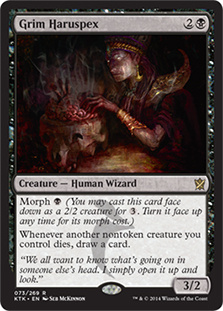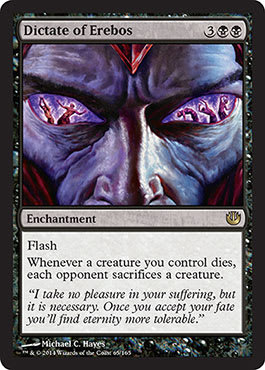 There are certain cards that speak to me. Most of the time, these are cards that mess with the process of dying. I have a fascination with eking value from creatures entering the graveyard. It probably has something to do with my sister smashing me with her Ashen Ghoul in 1995 and me coveting the card. Ashen Ghoul—it was one of those cards for me. The art was just subversive enough without being too gross for twelve-year-old Alex to handle. And since Alex the Kid didn’t really understand how to play Magic and would just attack as if it were required, well, he could always bring back the Ashen Ghoul . . . he would just have to run a few more creatures into combat. It’s win-win!
There are certain cards that speak to me. Most of the time, these are cards that mess with the process of dying. I have a fascination with eking value from creatures entering the graveyard. It probably has something to do with my sister smashing me with her Ashen Ghoul in 1995 and me coveting the card. Ashen Ghoul—it was one of those cards for me. The art was just subversive enough without being too gross for twelve-year-old Alex to handle. And since Alex the Kid didn’t really understand how to play Magic and would just attack as if it were required, well, he could always bring back the Ashen Ghoul . . . he would just have to run a few more creatures into combat. It’s win-win!
Poring over the Khans of Tarkir spoiler, I locked eyes with Grim Haruspex. Before she could cut open my skull and read the innards, I knew I would be ordering quite a few. Even now, almost twenty years later, I like to extract value from my discard pile. Creatures are going to die; why shouldn’t I profit? The thing is that it is very obvious how Grim Haruspex can be good—literally just put it next to other creatures, and boom: cards. The harder part is figuring out how to have Grim Haruspex and similar cards trigger at your leisure. Some of these are obvious; Goblin Bombardment and Blasting Station are staples in my playgroup, largely due to their enticing activation costs. As for me, I studied at the foot of a disciple.
Disciple of Griselbrand may not seem like much, but it can be a key piece of any deck that relies on creatures hitting the bin. Why? For an incredibly low investment, the student of the demon can turn on so many other aspects of a deck for certain commanders.
Who Plays 2-Drops?
Most of the time when someone plays a spell for 2 mana in a game of Commander, it is a ramp spell or a cheap counter. Maybe someone at your table loves to copy spells with Twincast. Most 2-mana creatures, though, either just sit there or enable silly things. Disciple is deceptive in this regard because it can very well do nothing. Sure, it can gain a few points of life from other beings on the way out, but really, it isn’t all that threatening.
And that is exactly why it is so dangerous.
While sweepers are commonplace and would take care of it anyway, Disciple of Griselbrand is rather innocuous. It doesn’t alter the game state when it hits the board and necessitates a small investment to be active. More than that, it needs other creatures, preferably with a high toughness, to really shine. But the fact is that it can sit there and eat utility creatures that are going to die all while buying time to bring the caster into a later stage of the game. And other cards that might help you survive have a harder time going through unscathed. Disciple of Griselbrand, on the other hand, can exist and progress the game to a point at which it has helped to craft a dominant board state.
Basically, this is life-gain stapled to a cheap creature. But it is the nature of the gaining life that matters.
The Ultimate Sacrifice
Let’s be real for a moment: No one is running Disciple of Griselbrand unless he or she can take advantage of the ability to remove creatures from the board at will. In a world in which Grave Pact, Butcher of Malakir, and Dictate of Erebos are viable build-arounds, being able to turn these control options on is a huge benefit. Disciple represents a huge threat of activation that can decimate a board. Disciple has the added bonus of being in the same color as these cards, and it flies under the radar. Compare it to Greater Good; which one looks more dangerous? Exactly.
Disciple of Griselbrand, therefore, becomes part of an overarching strategy in which sacrificing creatures is the name of the game. Naturally, it wants to remove big creatures (for the biggest boost in health), so working with green is a natural evolution. This is fantastic because it can turn on one of my favorite cards from Conspiracy: Deathreap Ritual. Deathreap Ritual is a quiet powerhouse, and with a steady supply of monsters, it can draw as many cards per turn cycle as there are players. I’ve said it before, but it bears repeating: Disciple’s ability to go unnoticed (and if I keep mentioning it, it won’t happen much longer) can allow the Deathreap Ritual to generate a snowball of card advantage.
On top of this, there are a few commanders just waiting for creatures to die on their own, including Athreos, God of Passage and Kresh the Bloodbraided. Disciple helps to switch these commanders into their on positions. There are less-legendary creatures that fit the bill as well, including:
And there are quite a few others
The point is to send fantastic beats to the graveyard, but that doesn’t mean they have to be cards.
Token Entry
Disciple of Griselbrand doesn’t care what it puts up on the altar. Unlike the Grim Haruspex (with whom I am still making eyes), Griselbrand’s minion is A-OK offering up tokens. The pieces are starting to come together, as dying tokens work very well with the triumvirate of black enhancements discussed above. Working alongside Rise of the Eldrazi unsung hero Pawn of Ulamog, an unchecked Disciple can flood the board with Spawn, which can then be turned into all sorts of things (including more life). Heck, even though it doesn’t make an appearance in my version of the deck, Disciple helps Sek'Kuar, Deathkeeper spew out Graveborn tokens.
These are just some of the places where Disciple of Griselbrand fits into a deck. Not only that, but there are other the ways I like to play Magic. I currently pack this Cleric in three decks: Jarad, Golgari Lich Lord, Lyzolda, the Blood Witch, and Teysa, Orzhov Scion. Let’s look at one of them.
Teysa, Orzhov Scion ? Commander | Alex Ullman
- Commander (0)
- Creatures (36)
- 1 Angel of Despair
- 1 Archon of Justice
- 1 Big Game Hunter
- 1 Blood Artist
- 1 Bone Shredder
- 1 Cemetery Reaper
- 1 Deathpact Angel
- 1 Disciple of Griselbrand
- 1 Emeria Angel
- 1 Falkenrath Noble
- 1 Geist-Honored Monk
- 1 Intrepid Hero
- 1 Karmic Guide
- 1 Maw of the Obzedat
- 1 Mentor of the Meek
- 1 Necrotic Sliver
- 1 Nether Traitor
- 1 Ogre Slumlord
- 1 Phyrexian Plaguelord
- 1 Reassembling Skeleton
- 1 Reliquary Monk
- 1 Requiem Angel
- 1 Sangromancer
- 1 Shriekmaw
- 1 Skirsdag High Priest
- 1 Stronghold Assassin
- 1 Sun Titan
- 1 Treasury Thrull
- 1 Twilight Drover
- 1 Twilight Shepherd
- 1 Solemn Simulacrum
- 1 Athreos, God of Passage
- 1 Darien, King of Kjeldor
- 1 Teysa, Envoy of Ghosts
- 1 Vish Kal, Blood Arbiter
- 1 Adarkar Valkyrie
- Planeswalkers (2)
- 1 Elspeth, Knight-Errant
- 1 Sorin, Lord of Innistrad
- Spells (25)
- 1 Grim Harvest
- 1 Mortify
- 1 Return to Dust
- 1 Austere Command
- 1 Life's Finale
- 1 Merciless Eviction
- 1 Unburial Rites
- 1 Attrition
- 1 Field of Souls
- 1 Grave Pact
- 1 Martyr's Bond
- 1 Martyr's Cause
- 1 Mobilization
- 1 Oblivion Ring
- 1 Oversold Cemetery
- 1 Underworld Connections
- 1 Blasting Station
- 1 Darksteel Ingot
- 1 Helm of Possession
- 1 Illusionist's Bracers
- 1 Journeyer's Kite
- 1 Mortarpod
- 1 Nim Deathmantle
- 1 Skullclamp
- 1 Sol Ring
- Lands (36)
- 9 Plains
- 10 Swamp
- 1 Barren Moor
- 1 Command Tower
- 1 Drifting Meadow
- 1 Evolving Wilds
- 1 Godless Shrine
- 1 High Market
- 1 Mystifying Maze
- 1 Orzhov Basilica
- 1 Polluted Mire
- 1 Secluded Steppe
- 1 Springjack Pasture
- 1 Tainted Field
- 1 Temple of Silence
- 1 Temple of the False God
- 1 Terramorphic Expanse
- 1 Winding Canyons
- 1 Kor Haven
Teysa is the deck I bust out when I want to control the board state. It started as a theme deck around human sacrifice, but Teysa’s evolved into a deck built around generating tokens and then sacrificing them for a huge gain. Disciple of Griselbrand is just one part of this plan, as it works with Blasting Station, Mortarpod, Phyrexian Plaguelord, Helm of Possession, and more to keep the flow to the grave steady.
This is where phase two of the plan goes into effect. Pawn of Ulamog, Twilight Drover, Field of Souls, Requiem Angel, and Ogre Slumlord provide rewards for all the death. These, in turn, feed the monster anew. Eventually, Maw of the Obzedat will come down and help the token army punch through for major damage.
In order to keep the machine moving, the cards must flow, and that is where Mentor of the Meek and Skullclamp shine. With so many small creatures running around, Skullclamp can go rather bonkers, and since so many of these creatures are small, Mentor keeps the march over the cliff going strong.
Teysa’s is a slow deck that needs time to set up. When played correctly, it does not look very threatening at first. But like Disciple of Griselbrand, when all the pieces are in place, it is a force to be reckoned with.
What about you? What am I missing in Teysa’s list? Where would you use Disciple of Griselbrand? Let us know!




























